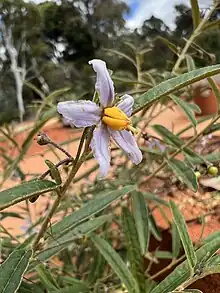| Seringia integrifolia | |
|---|---|
 | |
| Scientific classification | |
| Kingdom: | Plantae |
| Clade: | Tracheophytes |
| Clade: | Angiosperms |
| Clade: | Eudicots |
| Clade: | Rosids |
| Order: | Malvales |
| Family: | Malvaceae |
| Genus: | Seringia |
| Species: | S. integrifolia |
| Binomial name | |
| Seringia integrifolia | |
| Synonyms[1] | |
|
List
| |
Seringia integrifolia, commonly known as common firebush,[2] is a species of flowering plant in the family Malvaceae and endemic to the south-west of Western Australia. It is a small, much-branched shrub, its young growth densely covered with woolly, white or rust-coloured hairs. The leaves are oblong, 8.5–17 mm (0.33–0.67 in) long, more or less glabrous on the upper surface and densely covered with woolly white hairs on the lower surface. The flowers are arranged in small, loose groups with thin, egg-shaped bracts that fall off as the flowers open. The sepal lobes are broad, pointed, mostly 6.5–8.5 mm (0.26–0.33 in) long and the ovary has 5 carpels with about 4 ovules in each. The fruit is a spherical, softly hairy capsule.[3]
This species was first formally described in 1845 by Ernst Steudel, who gave it the name Keraudrenia integrifolia in Lehmann's Plantae Preissianae from specimens collected near the Swan River in 1839.[4][5] The specific epithet (integrifolia) means "whole-leaved", referring to the leaves that lack serrations or lobes.[6]
In 1860, Ferdinand von Mueller changed the name to Seringia integrifolia in his Fragmenta Phytographiae Australiae.[7][8]
Seringia integrifolia is found in the Avon Wheatbelt, Esperance Plains, Geraldton Sandplains, Jarrah Forest, Swan Coastal Plain and Yalgoo bioregions of south-western Western Australia.[2]
References
- 1 2 "Seringia integrifolia". Australian Plant Census.
- 1 2 "Seringia integrifolia". FloraBase. Western Australian Government Department of Biodiversity, Conservation and Attractions.
- ↑ Bentham, George (1863). Flora Australiensis. London: Lovell Reeve & Co. p. 247. Retrieved 12 April 2023.
- ↑ "Keraudrenia integrifolia". Australian Plant Name Index. Retrieved 12 April 2023.
- ↑ von Steudel, Ernst G. (1845). Lehmann, Johann G.C.; Preiss, Ludwig (eds.). Plantae preissianae sive enumeratio plantarum quas in australasia occidentali et meridionali-occidentali. Hamburg: Sumptibus Meissneri. p. 236. Retrieved 12 April 2023.
- ↑ Sharr, Francis Aubi; George, Alex (2019). Western Australian Plant Names and Their Meanings (3rd ed.). Kardinya, WA: Four Gables Press. p. 225. ISBN 9780958034180.
- ↑ "Seringia integrifolia". Australian Plant Name Index. Retrieved 12 April 2023.
- ↑ von Mueller, Ferdinand (1860). Fragmenta Phytographiae Australiae. Vol. 2. Melbourne: Victorian Government Printer. p. 5. Retrieved 12 April 2023.